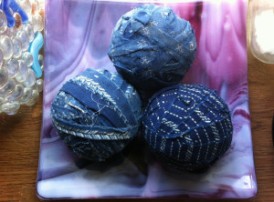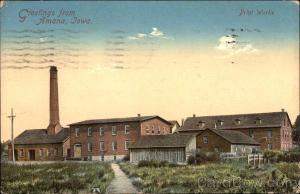![A2Z-BADGE [2016]](https://vintagedazecolumn.files.wordpress.com/2016/04/a2z-badge-2016.jpg?w=676)
R: Rag Balls & Technology
As enamored as I am with the past and the ‘good ‘ole days’, technology has invaded our lives and I have to accept it. For the most part, I’m glad. Okay, I could easily regress to the days when cell phones were not permanent attachments to everyone and we could meet friends for dinner without half of the table constantly texting or checking their Facebook page. But, overall, I do appreciate the electricity, the air conditioning, the refrigerators … and the indoor restrooms, to name just a few.
Moments arise that showcase how much technology has changed our lives.
A few nights ago I was musing over an idea for this blog while headed for bed. No – not that. No – don’t feel like writing about that. No – too much research for that subject.
 Rag balls! The rag balls I brought back from Iowa. Yes, that’s what I’ll write about. Now …where were they from?
Rag balls! The rag balls I brought back from Iowa. Yes, that’s what I’ll write about. Now …where were they from?
I picked up my phone. Scrolling through pictures, I found the picture I’d taken in the antique store in Bedford where I’d discovered these fabric delights. The owner had a note explaining the basketful of rag balls. I knew I’d forget what it said. I had whipped out my phone and a snapshot later I had it all down for future reference. Which, I did indeed need.
“Amana Blue Calico … produced up until the start of WWI … no longer able to purchase dyes from Germany … factory located in main Amana …”
Perfect! Now I just needed to research Amana. Ugh. I’d already put the computer to bed in the other room. I didn’t feel like returning to the main part of the house. I didn’t want to pull the laptop out and turn it all back on. Such a hassle. I mean, after all, it would take all of two or three minutes for this whole process.
No, I don’t have to. The phone. You know that good ‘ole cell phone I was complaining about a few paragraphs ago? A little slide here, a quick tap here, a few words typed into a search engine and instantly I had more information than I needed.
It’s amazing. I thought of how it would have been, not so many years back. A great idea would pop into mind at eleven at night. No libraries open at that time of night. It would have to wait until the next day. After work I could stop by the library. And then — spend how much time searching through the card catalog? IF there was anything available. IF the library even had a book on the subject. IF it wasn’t checked out by anyone else. IF it was missing in action as library books are apt to be occasionally. Maybe a few days – or weeks – later I’d have the information I needed.
I guess I won’t be tossing this cell phone away today. Maybe I will embrace this new technology, since it makes my trips back into time easier and more productive than ever before.

Print Works Factory Amana, IA
The Amana Colonies in Iowa has its roots in Germany. Seeking freedom from religious persecution, the community came to America in 1843-1844. They purchased 5,000 acres near Buffalo, New York and called themselves the Ebenezer Society.
Requiring more farmland for their growing community, they moved to Iowa in 1855. Choosing the name Amana, which means to ‘remain true’, six villages were established, with a seventh village added in 1861.
Also in 1861, they built the Amana Calico Mill which supported the community, along with the wool mill. At its peak the calico mill produced up to 4500 yards of cotton yardage. The print factory obtained white cotton fabric from the south. The white muslin was acid-proofed and dyed in indigo vats a story high. The factory expanded to eight buildings, each one housing a different department: washing, drying, dyeing, printing, trimming, inspecting, packing, and shipping.
Calico fabrics sold for about six cents a yard at the turn of the century. Goods were sold in the Amana General Stores. Salesmen also traveled, carrying sample books with a variety of designs and colors available. Most often used for clothing, small scraps found themselves stitched into quilt pieces. Larger pieces and worn out clothing were ripped into strips and wound into rag balls to be used in woven rag rugs.
The Amana colonists obtained their indigo dyes from I.G. Farber Company in Germany. With the advent of World War I and the British naval blockade, the mill was unable to obtain the dyes necessary for their specialized prints. The factory closed down, never to create its blue dyed calicos again.
Two buildings remain that now house the Amana Furniture Shop. Meanwhile in attics, small stashes of indigo rag balls are discovered, making their way to antique stores. Three of these now reside in a new home in Texas, a remnant of the past – although it was technology that shared the history behind these three fabric spheres.
Check out their site for more about the Amana Colonies and the Amana Heritage Museum.
You know I thought rag balls were rest material left over before I began reading your article. What I didn’t know was where it all started and about the Amana colony and also that they originally came out of Germany looking for religious freedom.
If I am not mistaken the I.G Faber was also the I.G. House that the American Army had as the 5th Army Division Headquarters after the second world war. However I am not sure on this one. Have to go research it on Google.
Thank you for a very interesting article on rag balls that I enjoyed reading.
Visiting from the A to Z Blog Challenge.
Shalom,
Patricia @ EverythingMustChange
LikeLiked by 1 person
I’m not sure, Pat. I’ll have to go take a look and check it out. Not that I mind, I love researching! I could research all day long…except then my blogs wouldn’t get written lol
LikeLike